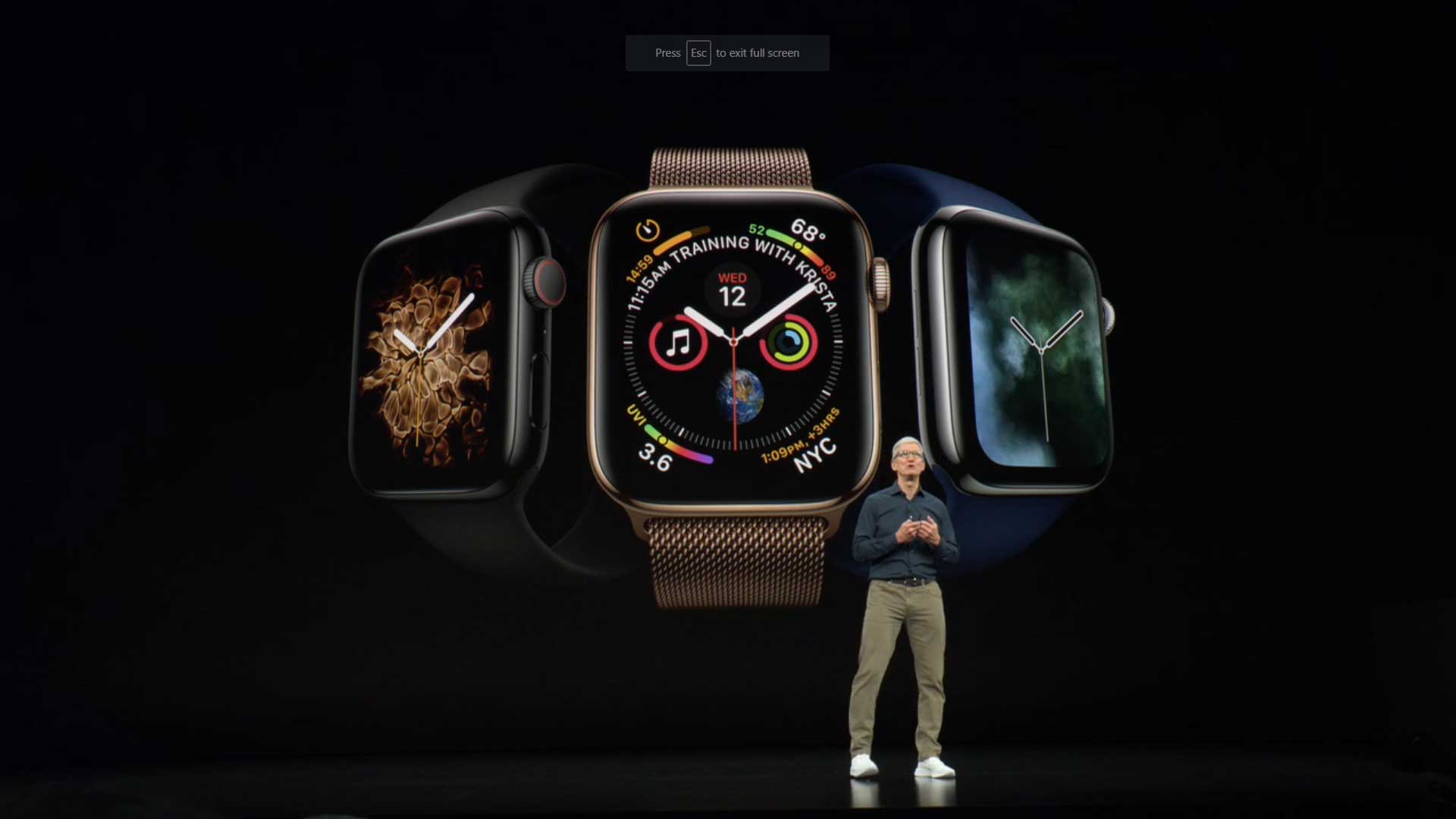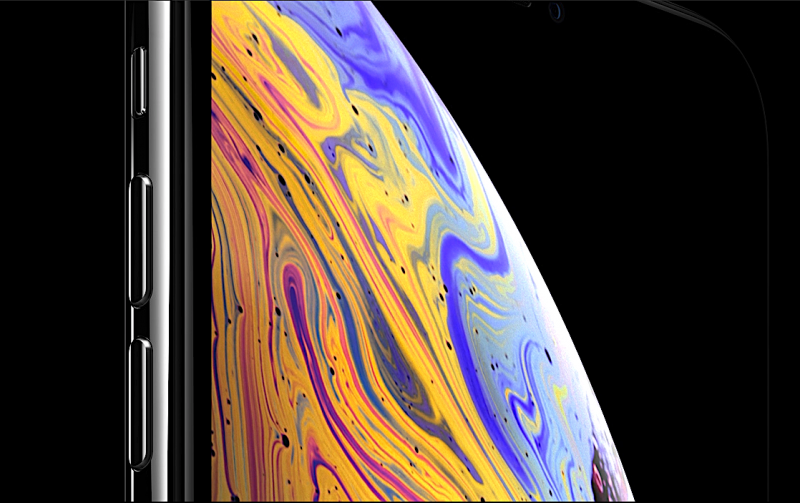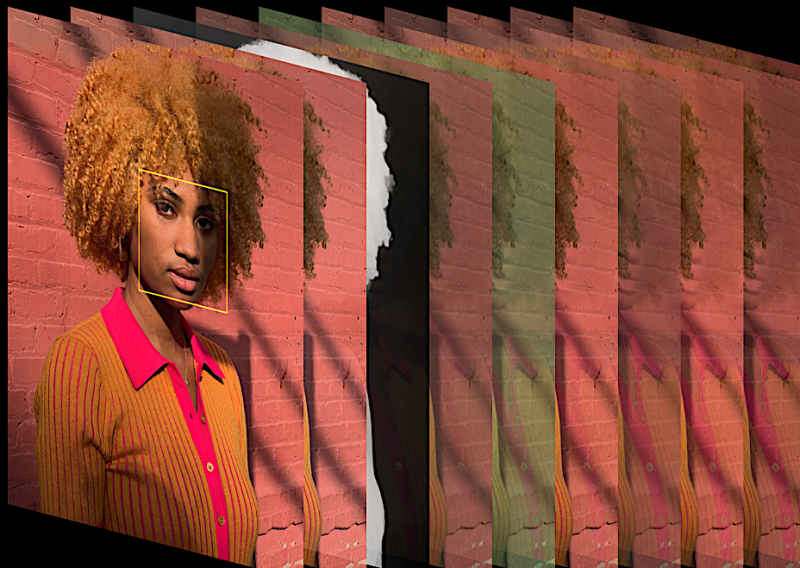 EMERGING TECH
EMERGING TECH
 EMERGING TECH
EMERGING TECH
 EMERGING TECH
EMERGING TECH
Apple Inc. took to the world stage today to announce a new Apple Watch and three new iPhone models called the XS, the XS Max and the XR, all in a typically slick and bewitching announcement at the Steve Jobs Theater in Cupertino, California headquarters.
The announcement’s keynote, led by Apple Chief Executive Officer Tim Cook (pictured), was streamed on Apple’s website as well as Twitter from Apple’s eerily empty profile, where almost nothing ever gets posted unless something is going on. Here’s a rundown of the announcements for those who didn’t get a chance to watch:
First, Cook presented the next-gen Series 4 Apple Watch that includes better hardware and all-new heart health features. Second, Cook announced three new iPhone models with the XS, XS Max and the XR — all of which include new features, access to iOS 12, and new hardware and software.
To set things off, Apple’s Twitter page posted an “accidental” (now deleted) tweet from Tim Cook saying, “Who can get it here quickly?” The tweet was a mystery until the keynote began eight minutes later.
The keynote started with a “Mission Impossible”-themed video displaying a young woman racing from an office high up in Apple’s headquarters holding a silver case. During the video, she asked Siri how to reach the theater, then tromped through a fountain, raced across a lawn filled with lawnmowers and parkoured through a cafeteria — all in a mad rush to get the case to Cook at the theater. He opened it and found … the clicker for presenting slides, stepping from the video onto the stage.
To open the keynote, Cook began with a statistic: that the company is soon to ship its 2 billionth iOS device.
The next generation of Apple Watch will be the Series 4. It includes an all-new design, a bigger display, a bevy of advanced heart health-related features and a more advanced wearable operating system.
“This category of item didn’t even exist a few years ago, and now Apple Watch is not only the No. 1 smartwatch in the world, it is the No. 1 watch, period,” said Cook.
The screen of the watch pushes to the very edges with no bezel and curved edges to match the shape of the watch. The screen is 30 percent larger and the Series 4 is a thinner watch than the Series 3. It includes an upgraded display to take advantage of the greater size.
The watch face includes eight different regions that can be customized with whatever the customer wants to see at a glance while also seeing the time. It even includes a way to add regular contacts, so it’s possible simply to tap an icon to call that person.
Several new dynamic watch faces have been added that dynamically interact with the shape of the display. For example, the “fire face” and “water face” take advantage of the display to provide an animated display to make the watch more interesting to look at when idle.
The knob on the site of the Series 4 has been redesigned to include haptic feedback, which gives it a mechanical feel that makes it easier to scroll through displayed information. It has an upgraded speaker that is louder than before and the microphone has been moved as far away from the speaker as possible to reduce echo and noise.
The Series 4 will also include a 64-bit dual-core processor designed to be two times faster performance than the previous series.
In addition, the watch includes a next-generation accelerometer and gyroscope providing twice the dynamic range. That allows the Series 4 to detect dangerous falls. Apple conducted studies with thousands of people to capture data on “real world falls.” If the watch detects a fall, it allows users to call for emergency help via an alert; however, if the watch detects a fall and remains immobile for 60 seconds, it will begin its own emergency dial, including the location of the wearer.
The Series 4’s heart rate sensor has added three new heart features. First, a notification pops up if the heart rate appears to be too low — for example, bradycardia. Second, the Series 4 can now screen the heart rhythm and can send a notification if it detects abnormal beats, such as with atrial fibrillation. Third, a new electrical heart sensor can take an electrocardiogram, also known as an ECG, which can classify different heart rhythms to help define symptoms that can be shared with a doctor.
“Capturing meaningful data about a person’s heart in real time is changing the way we practice medicine,” said Ivor Benjamin, president of the American Heart Association, who called this feature game-changing. “In my case, people often report symptoms that are absent during their visit. This is why data is vital.”
This feature of the Series 4 is also been cleared by the United States Food and Drug Association and it is a “de novo” clearance, meaning it is the first of its kind to be accepted. All medical and health information gathered by and stored by the Series 4 is encrypted on the device and in the cloud.
“The biggest feature added to Watch, besides the larger viewable image area was its heart health features, in particular, its ability to perform an ECG and also can detect AFib,” said Patrick Moorhead, president and principal analyst at Moor Insights & Strategy. “Add that to fall detection and notification and I can see kids buying one for their parents and grandparents. Apple opened the aperture again and I believe Series 4 will sell better than all previous models.”
Moorhead called out the custom processor embedded in the Apple Watch as its touchstone. Putting a 64-bit, dual-core chip into the wearable, he said, gives it the processing capability it needed to provide all the new features presented at the announcement.
Apple Watch Series 4 with GPS starts at $399 and Series 4 with cellular starts at $499. The Series 4 begins shipping Sept. 21 and will be available that day.
The iPhone XS is touted as the most advanced iPhone supporting the next-gen operating system with iOS 12 and an onboard chip called the A12 Bionic, a powerhouse of a computational engine coupled with a graphics processor and neural processing capability.
The new iPhone is made of surgical-grade stainless steel with a sleek gold finish on the front and on the glass. It’s covered front to back with the most durable glass that has ever been used. The phone can survive up to 30 minutes in water, meaning that it can be dropped into the pool or a glass of beer and retrieved with less likelihood of ill effects.
 The display on the iPhone XS stands out from its predecessors with a 5.8-inch Super Retina organic light-emitting diode display with 2.7 million pixels and 458 pixels per inch, supporting a display capable of playing HDR movies and supports the latest formats from Dolby and others. With this technology, the phone also supports a 60 percent greater dynamic range for more vibrant colors.
The display on the iPhone XS stands out from its predecessors with a 5.8-inch Super Retina organic light-emitting diode display with 2.7 million pixels and 458 pixels per inch, supporting a display capable of playing HDR movies and supports the latest formats from Dolby and others. With this technology, the phone also supports a 60 percent greater dynamic range for more vibrant colors.
The iPhone XS comes in a bigger iPhone XS Max model with a huge 6.5-inch Super Retina display, also an OLED display with 3.3 million pixels and 458 pixels per inch. The sound system is also upgraded, providing stereo sound with a wider stereo field from powerful speakers and adaptive software sound.
The new phone also includes Apple’s Face ID, a security capability that uses the camera system to scan the face of the person looking at the phone for identification. The system uses neural networks to recognize faces and unlock notifications and information and it does it faster than previous phones. Apple claims this is the most secure facial identification ever on a smartphone.
The device is powered by an A-series onboard central processing unit chip called the A12 Bionic. It is the industry’s first 7-nanometer chip, contains 6.9 billion transistors that power the neural engine, a six-core central processing unit and a four-core graphics processing unit.
The CPU contains two high-performance cores that are 15 percent faster and 40 percent lower power than the previous chip. The GPU can provide 40 percent faster rendering than its predecessor. The neural engine is an eight-core dedicated machine learning engine designed to power artificial intelligence analysis done on the device itself. The A12 neural engine is capable of processing 5 trillion operations per second.
“The A12 Bionic processor is a beast of a chip and will be the first 7nm chip to ship in a smartphone, meaning it can cram more features in it at the same size,” said Moorhead. “This year, Apple’s chip strategy shifted and it invested primarily into its Neural Engine and GPU versus CPU. This makes a lot of sense in that Apple already has a sizable lead in CPU performance and most of the new features delivered using ML and AI more highly leverage the neural processor and GPU.”
The new iPhone XS will launch with iOS 12, which is designed to take heavy advantage of the neural engine for entertainment options such as selfies that can embed augmented reality scenes and “animoji” character avatars that can mimic a major variety of facial expressions.
With iOS 12, the phone’s internals will also be opened up to CoreML, a major library that can drive numerous machine learning applications and augmented reality. It will also be able to hook up with ARKit 2, the next-generation of Apple’s AR library.
“Developers, who now have access to the neural engine, must now do things useful and meaningful to take advantage of the chip over and above what Apple is doing with its own software and apps,” said Moorhead. “Otherwise all this performance is for naught.”
The A12 Bionic chip and iOS 12 will open up possibilities for developers to produce games with high-fidelity graphics. For example, it will be able to power the mobile version of Bethesda Softworks LLC’s “The Elder Scrolls: Blades” (below) on mobile. All this allows the game to take advantage of the OLED screen, providing reflections, full-screen post-processing and immersive surround sound.

Augmented reality on iOS 12 with ARKit 2 can bring together multiple people for an AR gaming experience that is out of this world. For example, Directive Games’ “Galaga AR” brings the classic arcade experience of shooting science fiction space bugs out of the 2-D screen into full 3-D glory. It’s also possible to play the game simultaneously alongside several friends around a table in a way that has not been possible before.
The iPhone XS contains a 12-megapixel wide-angle camera with a six-element, 12-megapixel telephoto lens and an adaptive lighting system. On the front face of the camera, the iPhone XS has another high-quality camera and an infrared camera.
All of these cameras work together with onboard image signal processing that can use the A12 chip and its neural processor to help produce extremely high-fidelity photos and provide zero shutter lag even on subjects in motion. It does that by taking multiple pictures and merging them together to adjust to prevent blur caused by shake, while also adjusting for dynamic lighting conditions in what is called Smart HDR.

With this new hardware, the iPhone XS is also capable of changing “depth of field” to make the background/foreground sharper or software after the photo itself has been taken.
As for battery life, the iPhone XS can get up to 30 minutes longer than the iPhone 10 and the iPhone XS Max can extend that up to an hour and 30 minutes more.
The announcement wrapped up with the classic Jobsian “one more thing” — in this case, the iPhone XR, an aerospace grade aluminum-frame iPhone with durable glass and an edge-to-edge liquid crystal display.
The LCD display in the iPhone XR is named the Liquid Retina display and is 6.1 inches diagonally. It supports 1.4 million pixels, wide color range and true tone support. It supports a high-precision touch and contains all of the same front-facing camera technologies as iPhone XS and is capable of Face ID. It also contains the A12 Bionic chip.
“I believe Apple did enough at its launch with the launch of the XS Max, XS and XR to keep its smartphone growth going until the competition responds,” Moorhead said. “Not only did Apple expand the high-end position with the XS Max, it lowered the entry-level pricing on ‘edge to edge’ phones with the LCD-based XR. The XS is for consumers who want its highest-end features, but want a smaller form factor.”
The iPhone XS pricing starts at $999, the XS Max will start at $1,099. Preorders will start Sept. 15 and begin shipping Sept. 21. The iPhone XR pricing starts at $749.
THANK YOU